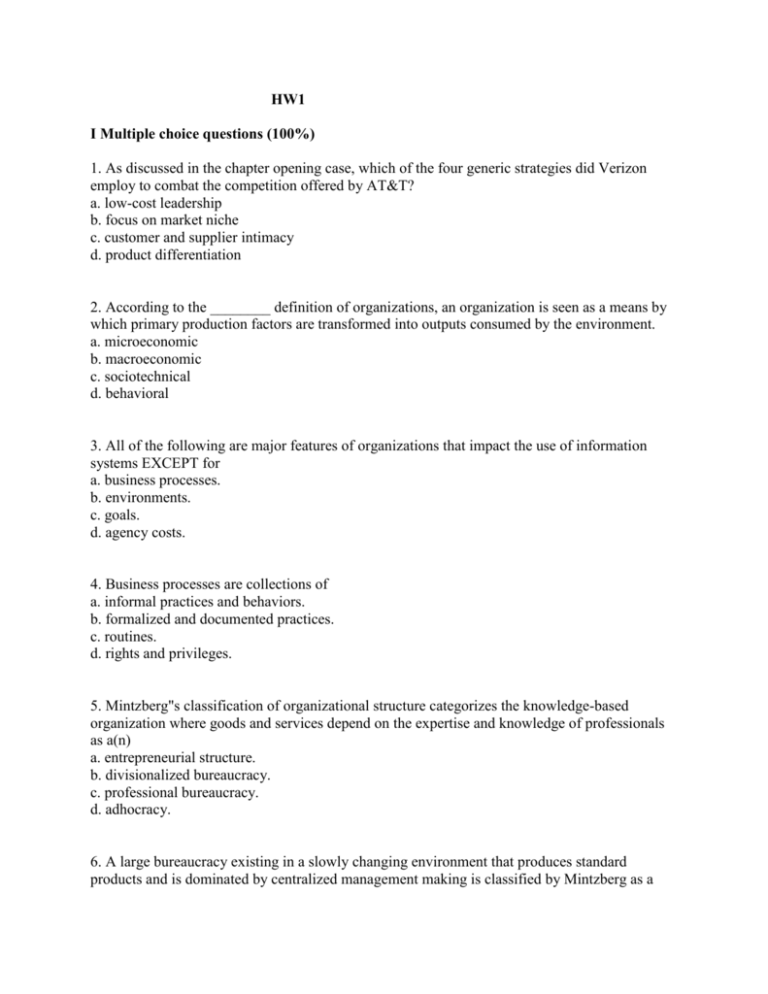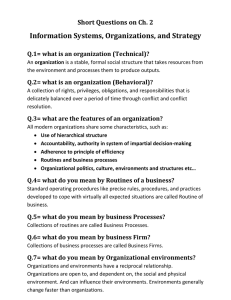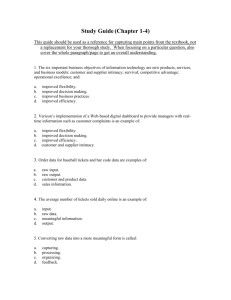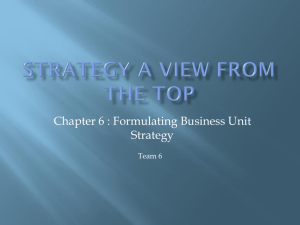Business Information Systems Homework 1: Multiple Choice Questions
advertisement

HW1 I Multiple choice questions (100%) 1. As discussed in the chapter opening case, which of the four generic strategies did Verizon employ to combat the competition offered by AT&T? a. low-cost leadership b. focus on market niche c. customer and supplier intimacy d. product differentiation 2. According to the ________ definition of organizations, an organization is seen as a means by which primary production factors are transformed into outputs consumed by the environment. a. microeconomic b. macroeconomic c. sociotechnical d. behavioral 3. All of the following are major features of organizations that impact the use of information systems EXCEPT for a. business processes. b. environments. c. goals. d. agency costs. 4. Business processes are collections of a. informal practices and behaviors. b. formalized and documented practices. c. routines. d. rights and privileges. 5. Mintzberg"s classification of organizational structure categorizes the knowledge-based organization where goods and services depend on the expertise and knowledge of professionals as a(n) a. entrepreneurial structure. b. divisionalized bureaucracy. c. professional bureaucracy. d. adhocracy. 6. A large bureaucracy existing in a slowly changing environment that produces standard products and is dominated by centralized management making is classified by Mintzberg as a ________ bureaucracy. a. machine b. professional c. divisionalized d. multidivisional 7. The costs incurred when a firm buys on the marketplace what it cannot make itself are referred to as a. switching costs. b. transaction costs. c. procurement. d. agency costs. 8. According to agency theory, the firm is viewed as a(n) a. unified, profit-maximizing entity. b. task force organization that must respond to rapidly changing environments. c. entrepreneurial endeavor. d. "nexus of contracts" among self-interested individuals. 9. According to Leavitt"s model of organizational resistance, the four components that must be changed in an organization in order to successfully implement a new information system are a. environment, organization, structure, tasks. b. technology, people, culture, and structure. c. organization, culture, management, and environment d. tasks, technology, people, and structure. 10. Which of the following is NOT one of the competitive forces? a. suppliers b. other competitors c. external environment d. customers 11. The ________ model is used to describe the interaction of external forces that affect an organization"s strategy and ability to compete. a. network economics b. competitive forces c. competitive advantage d. demand control 12. The four major types of competitive strategy are a. low-cost leadership; substitute products and services; customers; and suppliers. b. low-cost leadership; product differentiation; focus on market niche; and customer and supplier intimacy. c. new market entrants; substitute products and services; customers; and suppliers. d. low-cost leadership; new market entrants; product differentiation; and focus on market niche. 13. Wal-Mart"s continuous replenishment system allows it to a. provide mass customization. b. provide an efficient customer response system. c. strengthen customer intimacy. d. achieve economy of scale. 14. When a firm provides a specialized product or service for a narrow target market better than competitors, they are using a ________ strategy. a. product differentiation b. market niche c. mass customization d. process efficiency 15. Hilton Hotels" use of customer information software to identify the most profitable customers to direct services to is an example of using information systems to a. strengthen customer intimacy. b. differentiate their service. c. focus on market niche. d. increase efficiency. 16. Upon which of the following industries has the Internet as a whole been a disruptive technology? a. bill payments b. air travel c. books d. real estate 17. A rival of your company, AutoTown, is going to implement analytic software that mines customer data with a goal of enabling the building of automobiles that customers actually want. This can be categorized as using information systems for which competitive strategy? a. low-cost leadership b. product differentiation c. focus on market niche d. customer intimacy 18. To what competitive force did the printed encyclopedia industry succumb? a. positioning and rivalry among competitors b. low cost of entry c. substitute products or services d. customer"s bargaining power 19. The value chain model a. categorizes five related advantages for adding value to a firm"s products or services. b. sees the supply chain as the primary activity for adding value. c. categorizes four basic strategies a firm can use to enhance its value chain. d. helps a firm identify points at which information technology can most effectively enhance its competitive position. 20. Which of the following activities would you perform to measure and compare your business processes to similar processes of other companies within your industry? a. benchmarking b. best practices c. value chain analysis d. strategic systems analysis 21. The most successful solutions or methods for achieving a business objective are called a. value activities. b. best processes. c. core competencies. d. best practices. 22. A collection of independent firms that use information technology to coordinate their value chains to produce a product or service for a market collectively is called a(n) a. industry value chain. b. business ecosystem. c. value web. d. consortia. 23. An example of synergy in business is a. Amazon"s use of the Internet to sell books. b. JP Morgan Chase"s mergers with other banks that provided JP Morgan with a network of retail branches in new regions. c. Blockbuster combining traditional video rental with online video rental. d. Wal-Mart"s order entry and inventory management system to coordinate with suppliers. 24. The more any given resource is applied to production, the lower the marginal gain in output, until a point is reached where the additional inputs produce no additional output. This is referred to as a. the point of no return. b. the law of diminishing returns. c. supply and demand. d. network inelasticity. 25. Network economics a. applies the law of diminishing returns to communities of users. b. applies traditional economics to networked users. c. sees the cost of adding new members as inconsequential. d. balances the high cost of adding new members to a community against the lower cost of using network infrastructure. After studying the above questions, go online http://users.business.uconn.edu/whuang/opim3103/hw to answer the questions.











